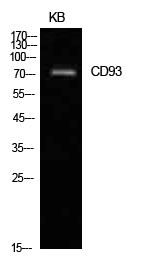CD93 Polyclonal Antibody
- Catalog No.:YT5597
- Applications:WB;ELISA
- Reactivity:Human;Rat;Mouse;
- Target:
- CD93
- Gene Name:
- CD93
- Protein Name:
- Complement component C1q receptor
- Human Gene Id:
- 22918
- Human Swiss Prot No:
- Q9NPY3
- Mouse Swiss Prot No:
- O89103
- Immunogen:
- The antiserum was produced against synthesized peptide derived from the Internal region of human CD93. AA range:191-240
- Specificity:
- CD93 Polyclonal Antibody detects endogenous levels of CD93 protein.
- Formulation:
- Liquid in PBS containing 50% glycerol, 0.5% BSA and 0.02% sodium azide.
- Source:
- Polyclonal, Rabbit,IgG
- Dilution:
- WB 1:500 - 1:2000. ELISA: 1:10000. Not yet tested in other applications.
- Purification:
- The antibody was affinity-purified from rabbit antiserum by affinity-chromatography using epitope-specific immunogen.
- Concentration:
- 1 mg/ml
- Storage Stability:
- -15°C to -25°C/1 year(Do not lower than -25°C)
- Other Name:
- CD93;C1QR1;MXRA4;Complement component C1q receptor;C1q/MBL/SPA receptor;C1qR;C1qR(p);C1qRp;CDw93;Complement component 1 q subcomponent receptor 1;Matrix-remodeling-associated protein 4;CD93
- Observed Band(KD):
- 110-120kD
- Background:
- The protein encoded by this gene is a cell-surface glycoprotein and type I membrane protein that was originally identified as a myeloid cell-specific marker. The encoded protein was once thought to be a receptor for C1q, but now is thought to instead be involved in intercellular adhesion and in the clearance of apoptotic cells. The intracellular cytoplasmic tail of this protein has been found to interact with moesin, a protein known to play a role in linking transmembrane proteins to the cytoskeleton and in the remodelling of the cytoskeleton. [provided by RefSeq, Jul 2008],
- Function:
- caution:Has been sometimes referred to as a collectin receptor.,caution:PubMed:11994479 reported that C1q is not a ligand for C1QR1.,function:Receptor (or element of a larger receptor complex) for C1q, mannose-binding lectin (MBL2) and pulmonary surfactant protein A (SPA). May mediate the enhancement of phagocytosis in monocytes and macrophages upon interaction with soluble defense collagens. May play a role in intercellular adhesion.,PTM:N- and O-glycosylated.,similarity:Contains 1 C-type lectin domain.,similarity:Contains 5 EGF-like domains.,subunit:Interacts with HCV core protein.,tissue specificity:Highly expressed in endothelial cells, platelets, cells of myeloid origin, such as monocytes and neutrophils. Not expressed in cells of lymphoid origin.,
- Subcellular Location:
- Membrane; Single-pass type I membrane protein.
- Expression:
- Highly expressed in endothelial cells, platelets, cells of myeloid origin, such as monocytes and neutrophils. Not expressed in cells of lymphoid origin.
- June 19-2018
- WESTERN IMMUNOBLOTTING PROTOCOL
- June 19-2018
- IMMUNOHISTOCHEMISTRY-PARAFFIN PROTOCOL
- June 19-2018
- IMMUNOFLUORESCENCE PROTOCOL
- September 08-2020
- FLOW-CYTOMEYRT-PROTOCOL
- May 20-2022
- Cell-Based ELISA│解您多样本WB检测之困扰
- July 13-2018
- CELL-BASED-ELISA-PROTOCOL-FOR-ACETYL-PROTEIN
- July 13-2018
- CELL-BASED-ELISA-PROTOCOL-FOR-PHOSPHO-PROTEIN
- July 13-2018
- Antibody-FAQs
- Products Images

- Western Blot analysis of KB cells using CD93 Polyclonal Antibody. Secondary antibody(catalog#:RS0002) was diluted at 1:20000
.jpg)
- Western Blot analysis of KB cells using CD93 Polyclonal Antibody. Secondary antibody(catalog#:RS0002) was diluted at 1:20000



